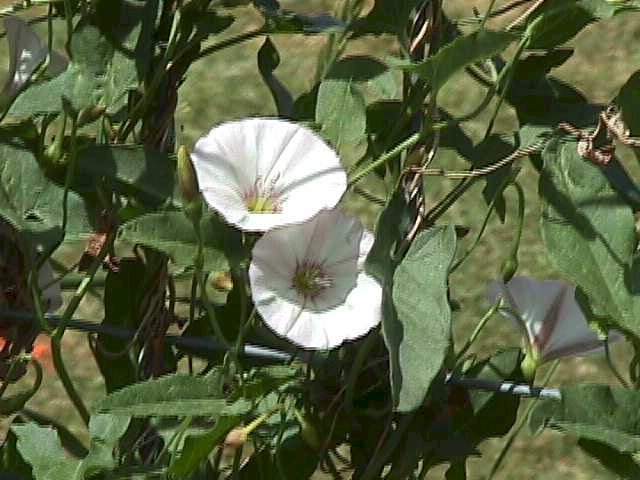field bindweed
(Convolvulus arvensis)
Weed ID Links Flowers and Leaves Flowers Climbing Plants Plant Infestation
Line Drawing - slow download Biological Control Chemical Control Cultural Control

Click on photo for larger view.
Photo by Todd Breitenfeldt, WHS science teacher.
Common names: wild mourning glory, creeping Jenny, and European bindweed.Roots: The roots of field bindweed, reproduce seeds and horizontal roots. A two or three year food supply is stored in an under ground root system of the plant. (1) The roots can grow up to five meters deep in the soil. Field bindweeds tap roots extend more than 3 meters in the soil. It also has an extensive system of lateral roots. (2)
Stems and Leaves: The leaves of field bindweed are smooth, slender, and slightly angled. The stems can be about one to four feet long. They spread thickly over the ground, and they wind around and strangle other plants and objects.(1) Their vine like stems trail on the ground or they wind around support. They also entangle surrounding plants. (3) The leaves are about one to two inches long, arrow shaped, with a blunt base. (1)
Flowers: The flowers of field bindweed are bell shaped. Many people mistake them for mourning glories. (6) The color of the flower can be white, pink, or variegated. The size of the flower is about 3/4 inches broad.(1) There are two small bracts that are 2.5 centimeters below the flower.(3)
Seeds: The seeds of field bindweed stay viable in the soil for up to 40 years. (1) They reproduce by seeds and rhizomes. The seed pods of field bindweed are pointed and five mm long. The plant also has four rough pear shaped seeds that grow in each pod.
Methods of Reproduction / Spread: Field bindweeds method of reproduction and spread are seeds, rhizomes and sprouting from the roots. (1)
Life Style/ Habits/ Life Duration: The stems of field bindweed can live up to fifty years. Field bindweed habits are winding around and infesting other plants and objects. (1)
Environments Favorable to Infestation: Field bindweed can be found in many different conditions, and at many elevations. It is also found in all types of ground such as, cultivated fields and waste places. Field bindweed grows best in fertile, dry, or semi~moist soils, and it is extremely difficult to control. (4)
Impacts: Field bindweed effects the area by strangling the surrounding plants and objects. (1)
Native Range/ Probable Entry to North America: Grows best in fertile, dry, or semi moist soils and extremely difficult to control.(4) In North America, Field bindweeed was first identified in Virginia in 1739. Field bindweed came here to the U.S. from Europe. (2)
Chemical Control: You can chemically control field bindweed by using herbicides, 2,4-D, glyphosate, and dicamba. You should use several applications at the beginning of June.
Cultural Conrol: Hoeing, pulling, or covering with a tarp does not work at all. (3)
Biological control: The insect Aceria malherbae nuzzaci helps control field bindweed by, attacking the leaves to make them fold inwards along the mid vein and they develop a fuzzy texture. Heavily invested shoots became stunted and distorted from this insect. (5) Also, goats and sheep will eat this plant. (6) The insect Tyta luctuosa (a dark brown moth) larvae will defoliate field bindweed
Bibliography :
1. Henry, Charlie, Colorado Weed Management Association. [online] available. www.fortnet.org/cwma/bindweed.htm, November 2, 1998.2. James, Jeff, Field Bindweed. [online] available www.members.aol.com/prideedu/bindweed.htm, November 5, 1998.
3. British Columbia Ministary of Agriculture and Food, [online] available www.agf.gov.bc.ca/croplive/weedguid/bindweed.htm, October 4, 1999.
4. Field bindweed, [onlive] available Www.arc.ab.ca/crop/weed/bindweedAgent.htm, April 16, 1997.
5. Nova Scotia Noxious Weeds, [online] available. agri.gov.ns.ca/pt/ipm/weeds/pibw9614.htm, May 26, 1997.
6. Brietenfeldt, Todd, Personal interview, Biology teacher, Whitehall High School, P.O. Box 1109, Whitehall Montana, 59759, September 9, 1999.
By: Tami Davis Published By: Mike Roylance
Back